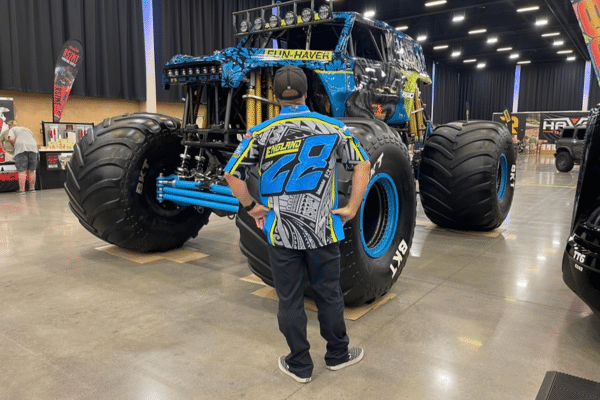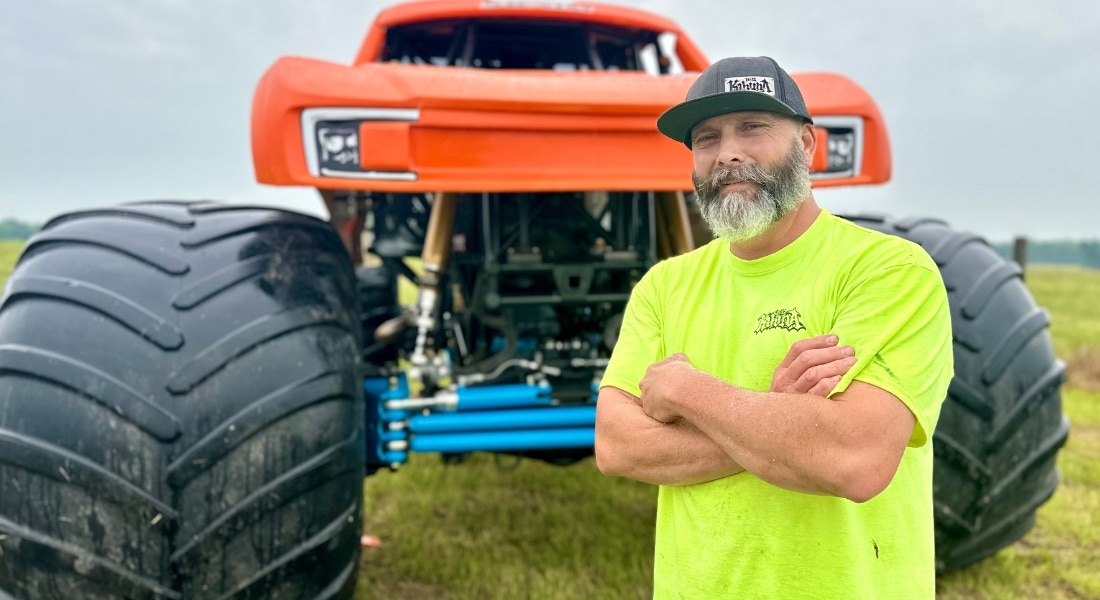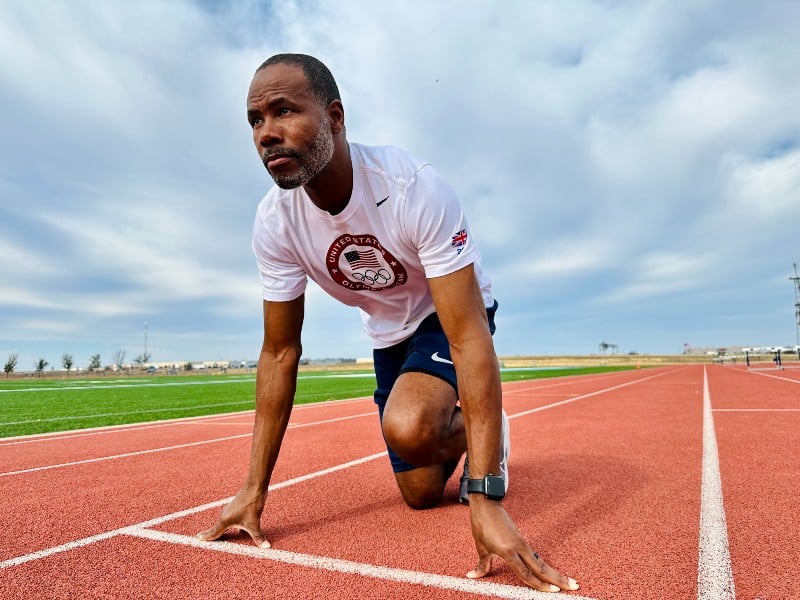Life is a thrill a minute for Shane England, who splits his time between offshore drilling rigs and building monster trucks in his East Texas auto shop. But a blockage in his “widow maker” artery nearly brought all that excitement to a heart-stopping end.
The 52-year-old owner and operator of the Big Kahuna monster truck was overdue for a visit to his cardiologist at Methodist Charlton Medical Center in July 2022 when he collapsed while running an errand on his own in rural East Texas.
“I was laid out for probably about 45 minutes on the ground with a concussion,” Shane says. “When I woke up, I didn’t have a clue where I was.”
In short order, he would be in the cardiac catheterization lab at Methodist Charlton where a stent was inserted to reopen his artery.
“I’ve been back and forth to Methodist Charlton several times for follow-ups, and I’m extremely happy with the care I’ve gotten,” Shane says. “And any increase in my blood pressure, I blame on the Dallas traffic.”

Shane builds and tests his trucks, including the Big Kahuna, on a track outside Paris, Texas.
OVERDUE FOR HEART EXAM
Traffic was the least of Shane’s worries when he saw stars shortly after the Fourth of July in 2022. He says he never experienced the common symptoms of heart disease: chest pain, sweating, and shortness of breath.
“I was loading up a fuel tank on my flatbed truck when, all of a sudden, there was a bright white light,” Shane says. “I passed out and hit my head against the top rail all the way down to the ground. I ended up with a concussion to go with the heart problem.”
That heart problem was acute coronary syndrome, also known as unstable angina, says Roberto Wayhs, MD, cardiologist on the medical staff at Methodist Charlton, whose office Shane was due to visit the very next day.
“I just got there a day early,” Shane jokes. “He wanted to do a heart cath on me a few weeks earlier, but I had to go to work.”
Work for Shane typically involves a helicopter ride to an offshore drilling platform, sometimes in the Indian Ocean or North Sea, so when he was loaded into a medical helicopter for a trip to Methodist Charlton, he felt at peace.
“The in-flight nurse was surprised when all my vital signs sort of leveled out, where most people are anxious,” Shane says. “I said, ‘Yeah I’ve been flying these things for 30 years, so my body just naturally calms down.’ I took the opportunity to take a nap.”

Racing and building monster trucks is all in the family for Shane, his son Tristan, and wife Laurie.
YOUNGER PATIENTS, TAKE HEED
Once he was on the ground in Dallas, Dr. Wayhs determined that Shane had narrowly avoided a heart attack, but his left anterior descending (LAD) artery was 99% blocked, preventing his heart from getting the blood it needed.
“It was a close call,” says Dr. Wayhs, who emphasized the importance for anyone with risk factors to routinely see a doctor. “Angina and heart attacks can happen in younger patients, but because they are so young and active, it takes longer for them to seek help.”
Shane, who is also diabetic, was first alerted to his heart problem by a physical just before an international work trip. He was skeptical when a doctor told him he may have already suffered a heart attack without knowing it.
“It could have been much worse if that work physical did not pick up Shane’s abnormal ECG and had not referred him for a cardiac evaluation,” Dr. Wayhs says. “Once we evaluated him it was clear that something was going on, and we recommended a cardiac catheterization.”
During this procedure, a tiny tube, or catheter, is threaded through an artery in the groin or wrist all the way to the patient’s heart. A tiny balloon at the end of the catheter can be used to push plaque out of the way and leave behind a tiny mesh scaffold, or stent, to keep the artery open.
“They placed the stent,” Shane says, “and I’ve been good ever since. I’ve just been following up every six months.”

Now fully recovered from his heart scare, Shane and Laurie are looking forward to keep on truckin’.
‘NOTHING BUT PRAISE’
His wife, Laurie, helps Shane keep those appointments, in spite of the four-hour round trip to Methodist Charlton from Powderly, just north of Paris, Texas.
“I have nothing but praise for that hospital,” Laurie says. “I could not ask for better doctors, the nursing staff — and the people in the ER were fabulous.”
Shane made a return trip to Methodist Charlton’s brand-new emergency department in February 2024, when a neglected case of kidney stones nearly turned septic.
“Again I was going to work when I should have been going to the doctor,” Shane admits. “I was in so much pain. By the time I got to the ER, they told me ‘You’re this close to dialysis.’”
Now fully recovered and back to living his best life, Shane is training others to drive the Big Kahuna and supporting his son, Tristan, who followed in his father’s giant tire tracks to win a Monster Jam World Finals championship just last year.
If Shane wants to see another generation conquer the monster truck world, Dr. Wayhs says he should keep a careful watch on his risk factors, including diabetes, blood pressure, and cholesterol.
“The doctor said to watch my diet and exercise, and I’ll be OK,” Shane says. “He’s always available to answer my questions, even when I’m out on the rig.
“And when I bring my wife to my follow-up visits,” he added, “they both can give me a hard time together.”






